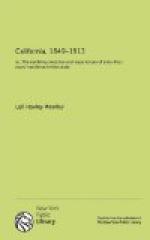We met some returning emigrants that morning who had become discouraged and were going back to their old homes This made me think of home and friends, the domestic happy fireside, and all that I had left behind, “but,” said I to myself, “this won’t do, I am too far out now; pluck is the word and I’m not going back on it.”
Early next morning we were once more upon our long journey, slowly traveling towards the far, far West.
The first place of interest that presented itself to our view was a narrow passage for the river between two perpendicular rocky banks, which were about one hundred feet high and looked as though a man could jump from one to the other at the top. This was called the “Devil’s Gate.” Above and below was the broad prairie.
At intervals along the Platte were villages of prairie dogs, who were about the size of large grey squirrels, but more chunky’ of a brownish hue, with a head somewhat resembling a bulldog. They are sometimes eaten by the Indians and mountaineers. Their earth houses are all about two feet deep; are made in the form of a cone; are entered by a hole in the top, which descends vertically some two or more feet and then takes an oblique course, and connects with others in every direction. These towns or villages sometimes cover several hundred acres and it is very dangerous riding over them on horseback.
We will now pass to another interesting object called “Chimney Rock” which is not altogether unlike Bunker Hill Monument. It stands by itself on the surrounding level country, with a conical base of about one hundred and fifty feet in diameter and seventy-five feet high where the nearly square part of the column commences, which is about fifty feet on each of the four sides. It is of sandstone and certainly a very singular natural formation. Altogether it is about two hundred feet high. I will mention here that the banks of the Platte are low, that the bed is of quicksand, that the river is very shallow and that it is never clear. One of our company attempted to ford it on foot. When about two-thirds over, in water up to his waist, he halted, being in doubt as to whether he should proceed or return. While hesitating between two opinions his feet had worked down into the quicksand and became so imbedded that he could not extricate them. Realizing his perilous position he at once gave the Masonic Grand hailing sign of distress and in a moment there were several men in the water on their way to his relief. They reached him in time and brought him safely into camp.
About this time there was considerable dissatisfaction manifested in camp on account of the slow progress we were making. Some left the train and went on by themselves, others realized the necessity of holding to together to the last in order to protect themselves as well as to care for those among us who were sick. The peculiar characteristics of the party at this time seemed to be recklessness and indifference to the situation, but the better judgment finally prevailed and we went on in harmony.




